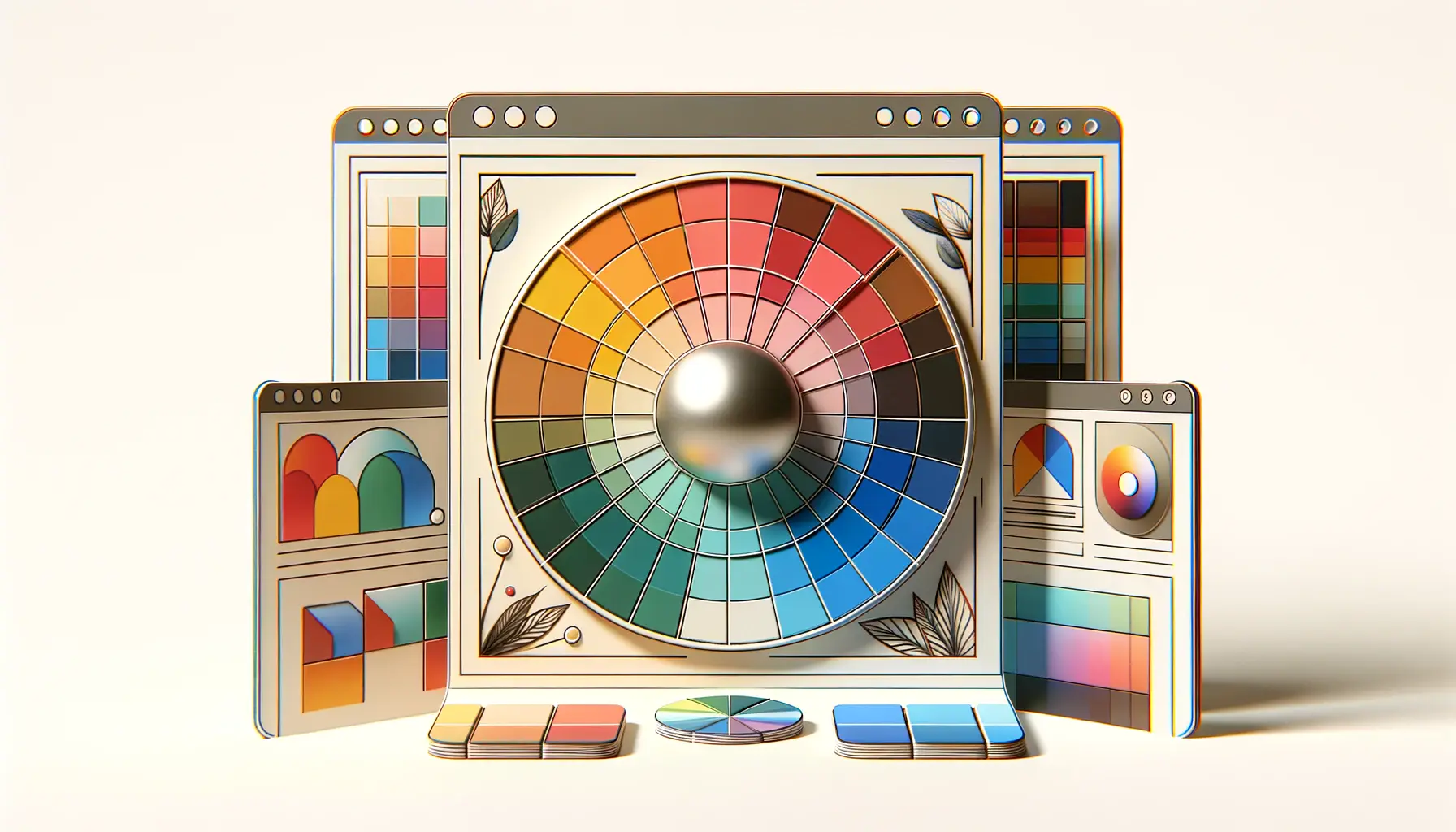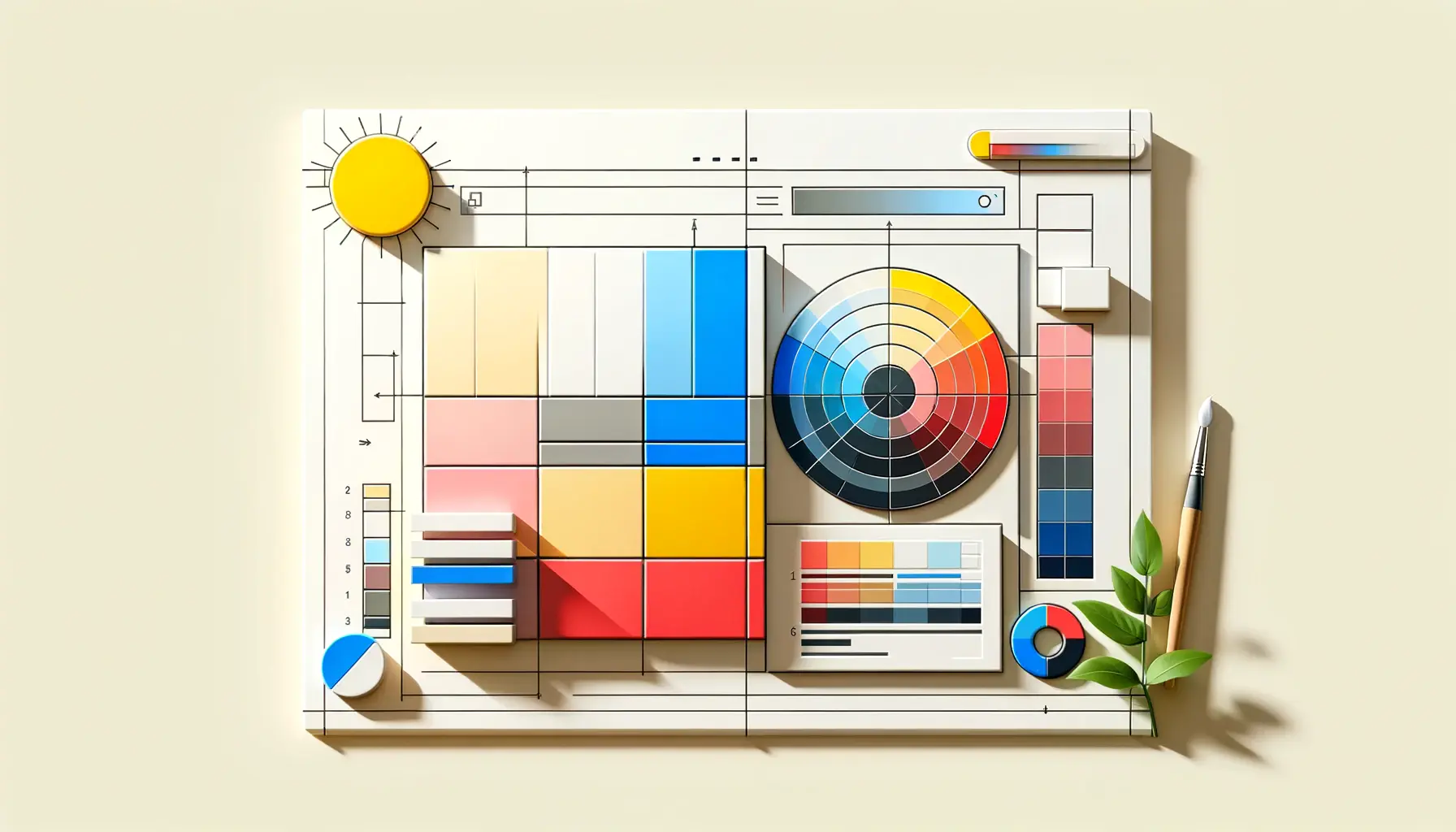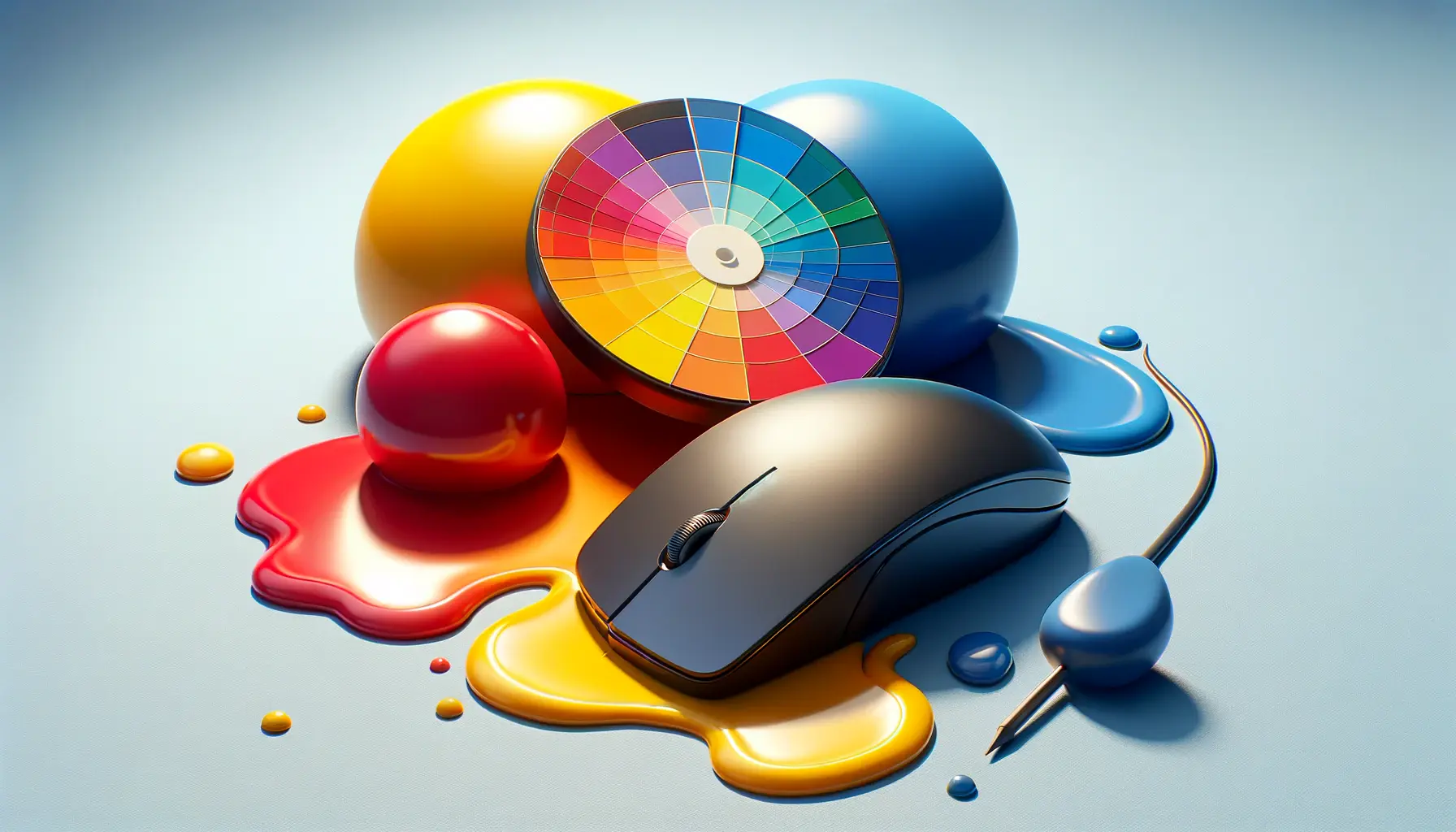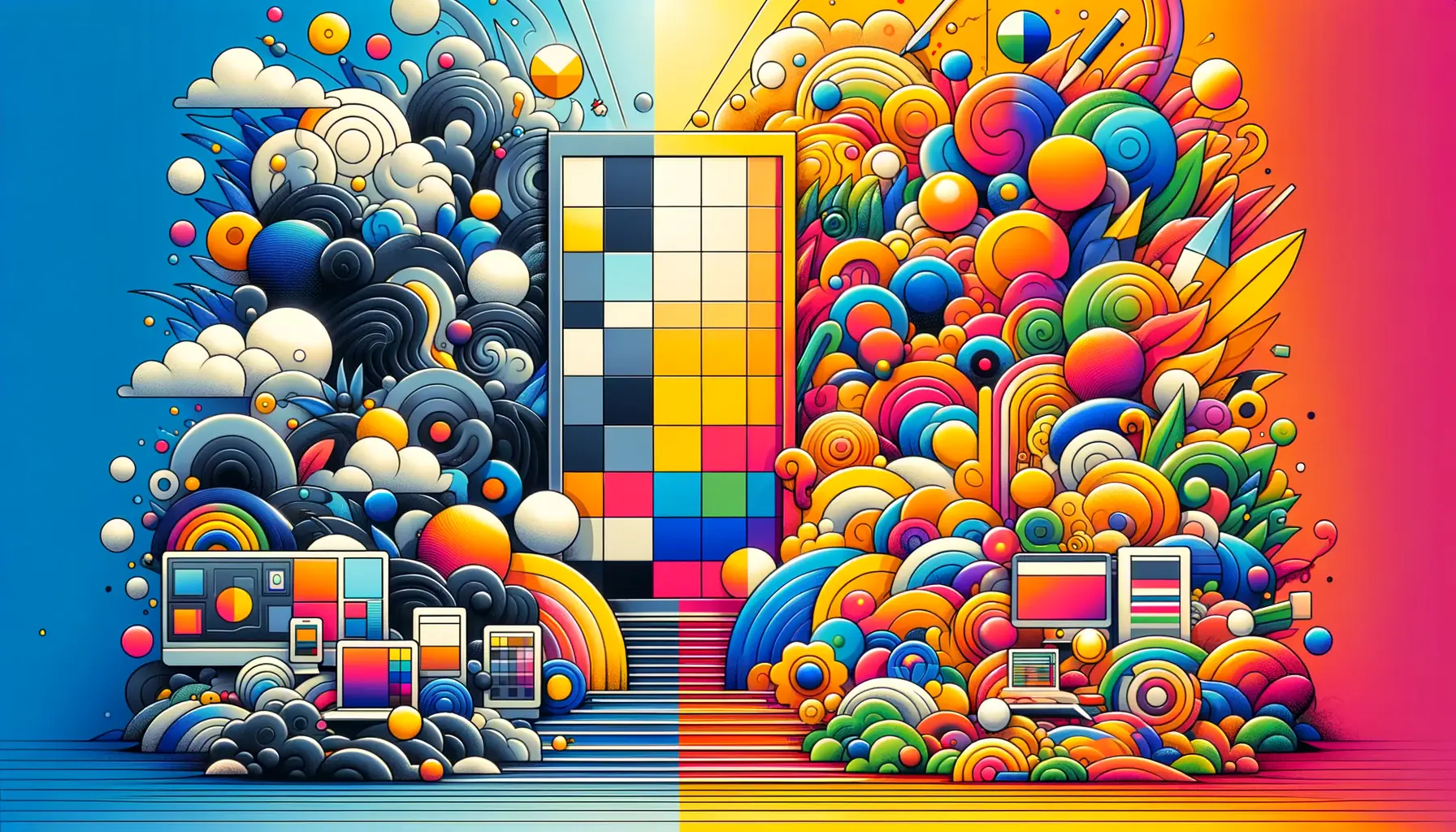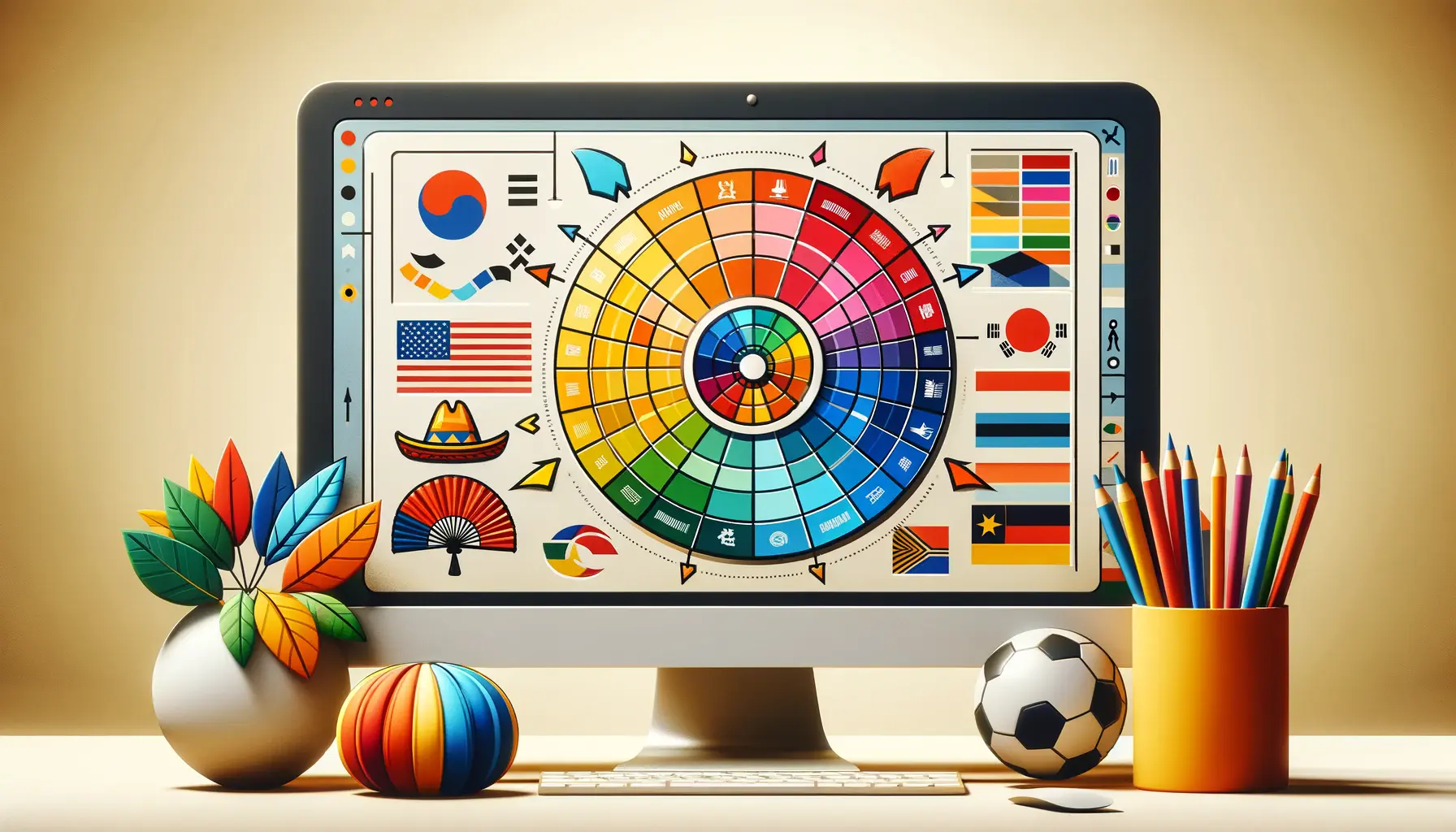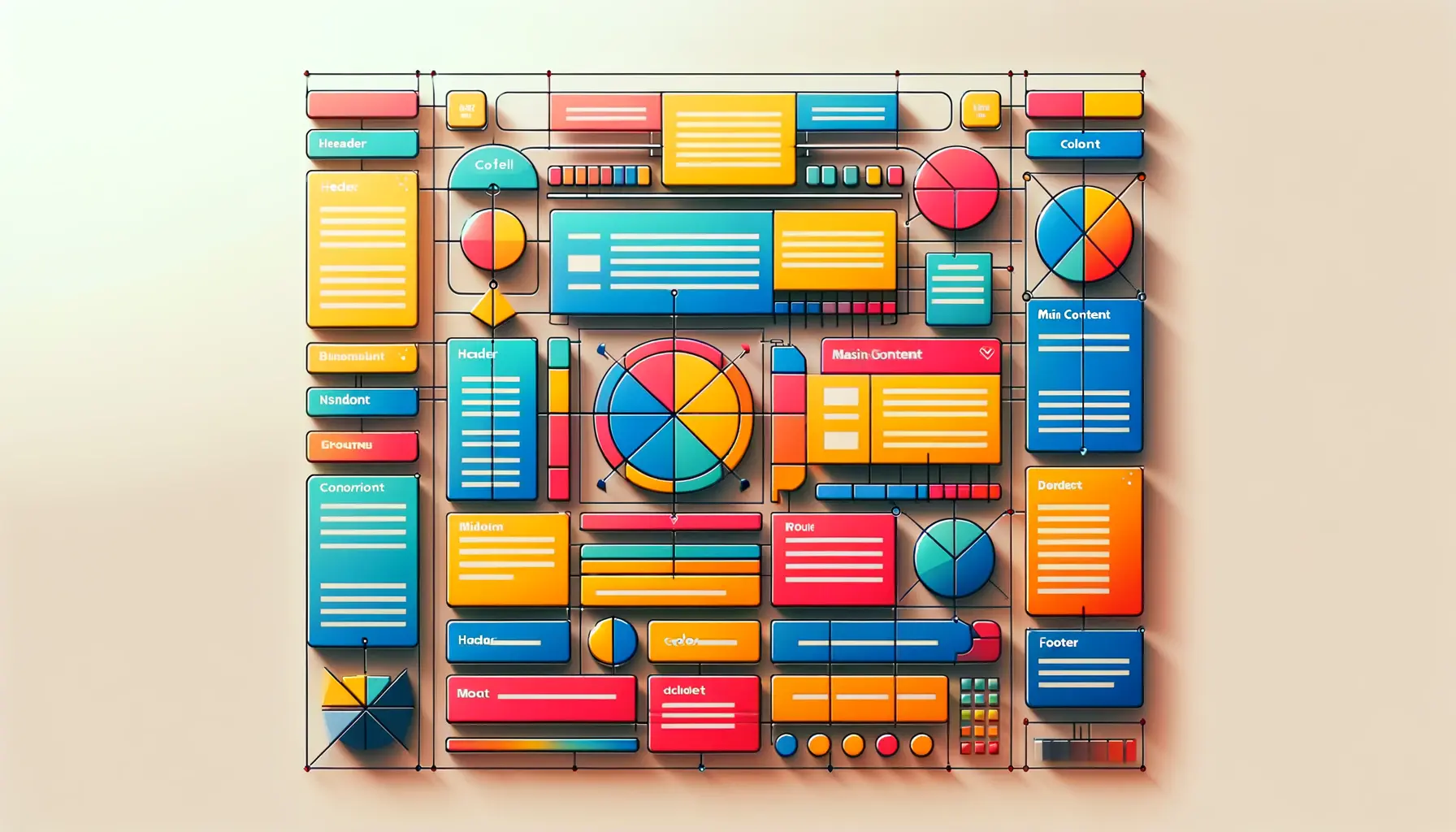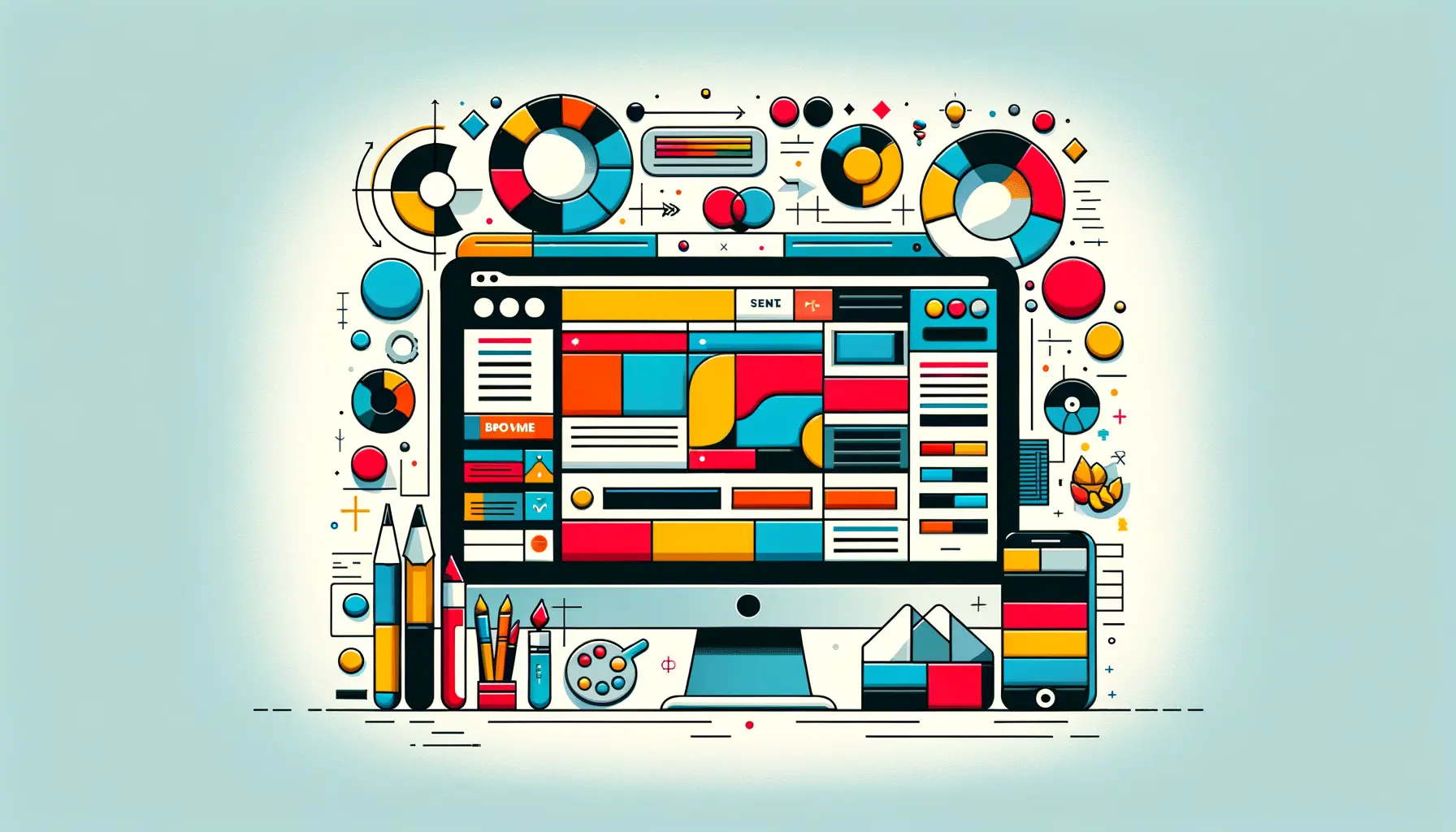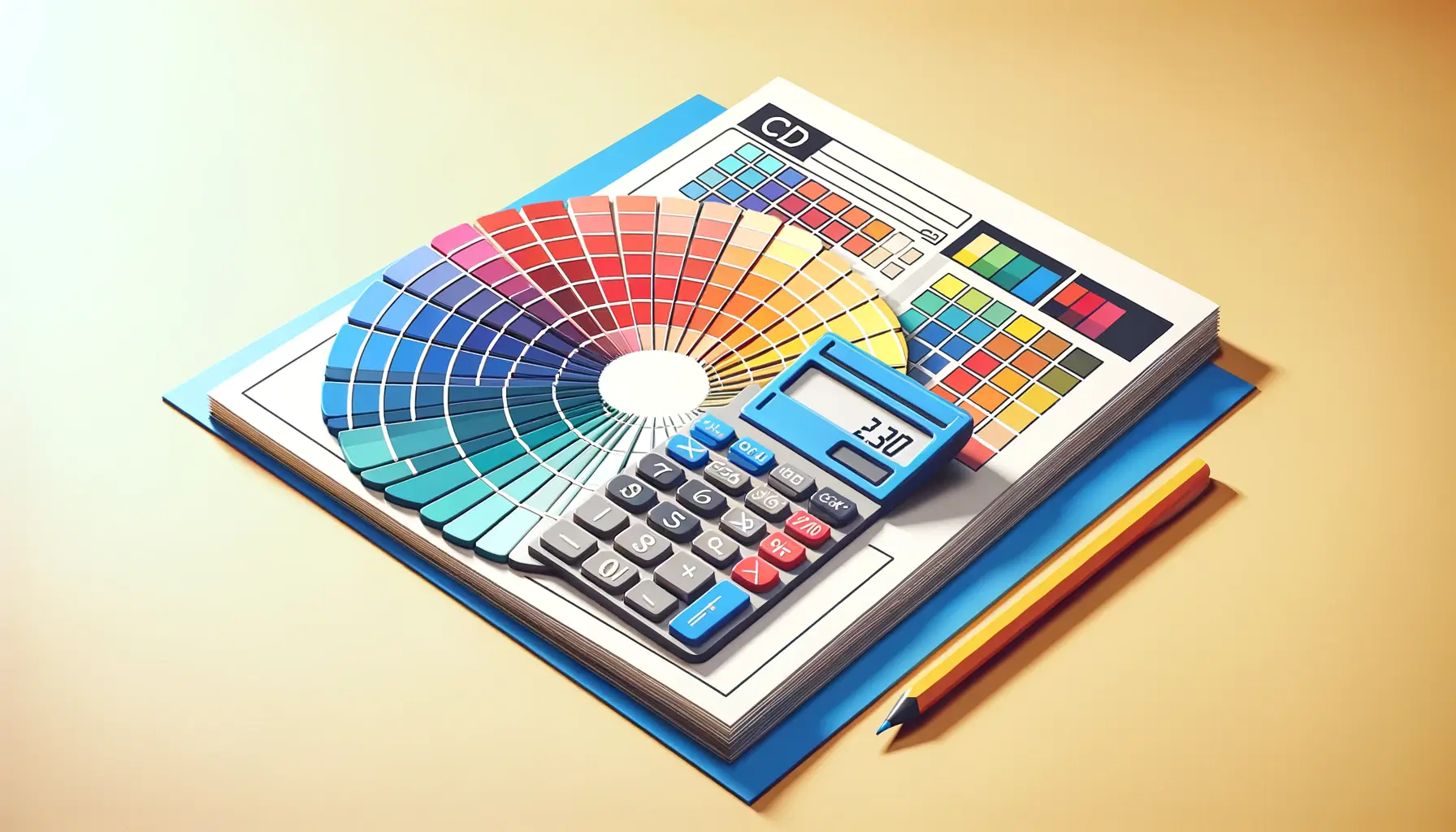Web design is an art form that combines aesthetics with functionality, aiming to engage users and enhance their online experience.
At the heart of this endeavor lies the strategic use of color, a powerful tool that can significantly influence user interaction and perception.
The application of color theory in web design goes beyond mere decoration; it’s about creating a visual language that communicates, persuades, and engages.
This article delves into how interactive elements, when infused with an understanding of color theory, can elevate the user experience on digital platforms.
Color theory, a cornerstone of design, explores the relationships between colors and their psychological effects on viewers.
In web design, leveraging color theory enables designers to craft interfaces that are not only visually appealing but also emotionally resonant and intuitive to navigate.
The strategic selection of color schemes can guide users’ attention, prompt actions, and even influence mood and behavior.
As we venture into the realm of interactive web design, the role of color becomes increasingly pivotal, shaping the way users interact with digital content.
- The Significance of Color in User Interaction
- Color Psychology in Web Design
- Implementing Color Accessibility in Web Design
- Color Schemes and Brand Identity
- Interactive Design and Color Dynamics
- Color Trends in Web Design
- Optimizing Web Design with Color Theory
- Harnessing the Power of Color Theory in Web Design
- FAQs on Creating Interactive Elements with Color Theory in Web Design
The Significance of Color in User Interaction
Color is not just a visual attribute; it’s a communicative tool that can convey messages and evoke responses without words.
In the context of web design, color plays a crucial role in creating interactive elements that are both engaging and functional.
Whether it’s a call-to-action button, a navigation menu, or an interactive infographic, the colors chosen can significantly impact the user’s decision to engage with the content.
By understanding the psychological effects of colors, designers can create interactive elements that resonate with the audience and encourage participation.
For instance, the use of a vibrant color like red for a call-to-action button can capture attention and suggest urgency, prompting users to click.
Conversely, a calming shade of blue for a website’s background can create a serene environment, encouraging users to stay longer and explore.
The choice of color, therefore, becomes a strategic decision that can enhance or hinder user interaction with web elements.
Enhancing Usability with Color Contrast
Contrast is a fundamental principle of color theory that has profound implications for web design, especially in creating interactive elements.
High contrast between text and background colors not only improves readability but also makes interactive components stand out.
This visual distinction is crucial for users to easily identify clickable elements and navigate a website effectively.
By employing contrasting colors, designers can guide users’ attention to key interactive elements, ensuring a seamless and intuitive user experience.
Moreover, contrast can be used to highlight the hierarchy of information, distinguishing primary actions from secondary ones.
For example, a brightly colored button for the main call-to-action on a page can be contrasted with more subdued colors for less critical actions.
This use of color contrast not only enhances the aesthetic appeal of a website but also its usability, making it easier for users to interact with the content.
The strategic use of color contrast can significantly improve the usability and navigability of a website, making interactive elements more prominent and intuitive for users.
Color Psychology in Web Design
Understanding color psychology is paramount in web design, as different colors can evoke different emotions and actions from users.
The psychological impact of color influences how users perceive and interact with a website, affecting their overall experience.
By carefully selecting colors that align with the website’s message and audience preferences, designers can create a more engaging and effective user interface.
Color psychology goes beyond the surface, tapping into subconscious associations that affect user behavior.
For instance, blue is often associated with trust and reliability, making it a popular choice for financial institutions and social platforms.
On the other hand, green is frequently used to denote growth and harmony, ideal for environmental organizations or wellness brands.
Recognizing these associations allows designers to craft web experiences that resonate deeply with users.
Strategic Use of Color to Drive User Action
Colors not only shape the aesthetic of a website but also guide user actions.
Strategic color choices can direct users’ attention to specific areas, encouraging interaction with certain elements.
This section explores how colors can be used to influence user behavior and enhance the interactive experience on a website.
- Call-to-Action Buttons: Vibrant colors like orange or red can make call-to-action buttons stand out, drawing users’ attention and prompting clicks.
- Navigation Menus: Using contrasting colors for navigation menus against the website’s background can improve visibility and usability, guiding users through the site’s content.
- Interactive Elements: Highlighting interactive elements such as forms or quizzes with distinctive colors can increase participation rates, making the interaction more appealing.
Creating Emotional Connections Through Color
Colors have the power to evoke emotions, creating a psychological connection between the website and its users.
This emotional resonance can enhance user engagement and foster a positive perception of the brand.
Below are examples of how color can be used to forge emotional connections:
- Warm Colors: Shades of red, orange, and yellow can evoke feelings of warmth and excitement, ideal for brands looking to convey energy and dynamism.
- Cool Colors: Blues and greens are calming, promoting trust and serenity, suitable for brands aiming to establish reliability and peace.
- Neutral Colors: Black, white, and gray offer a minimalist and sophisticated vibe, appealing to audiences looking for elegance and simplicity.
Incorporating color psychology into web design not only enhances the visual appeal but also deepens the user’s emotional connection to the website, influencing their perception and actions.
Implementing Color Accessibility in Web Design
Accessibility in web design ensures that websites are usable by everyone, including individuals with visual impairments or color blindness.
Color accessibility is a critical aspect of this, requiring designers to choose color schemes that are perceivable and distinguishable by all users.
This part of the article explores the importance of color accessibility and provides guidelines for implementing it effectively in web design.
Color accessibility enhances the usability of a website, making it inclusive and navigable for users with various types of visual impairments.
By adhering to accessibility standards, designers can create web experiences that are not only beautiful but also functional for a wider audience.
This commitment to inclusivity not only improves user satisfaction but also broadens the reach of the website.
Guidelines for Color Accessibility
To ensure color accessibility in web design, there are several guidelines designers can follow.
These guidelines help in creating a web interface that is accessible to users with color vision deficiencies or other visual impairments.
- Contrast Ratios: Maintain high contrast ratios between text and background colors to ensure readability. The Web Content Accessibility Guidelines (WCAG) recommend a minimum contrast ratio of 4.5:1 for normal text and 3:1 for large text.
- Avoid Color-Only Information: Do not rely solely on color to convey information. Use text labels, patterns, or icons in addition to color to ensure that information is accessible to everyone.
- Color Blindness Simulators: Utilize color blindness simulators and tools to test your design’s accessibility. These tools can help identify potential issues that might not be apparent to designers with normal color vision.
Tools for Testing Color Accessibility
Several online tools and software can assist designers in testing and improving the color accessibility of their websites.
These tools evaluate color schemes against accessibility standards, providing insights and suggestions for enhancements.
- WebAIM Contrast Checker: An online tool that allows designers to check the contrast ratio of text against its background color, ensuring compliance with WCAG guidelines.
- Color Oracle: A free color blindness simulator for Windows, Mac, and Linux that helps designers see how their designs appear to users with various types of color vision deficiencies.
- Coblis — Color Blindness Simulator: An online tool where designers can upload images of their designs to see how they might look to users with different types of color blindness.
Ensuring color accessibility is not just about compliance with standards; it’s about creating a web experience that is inclusive and usable for everyone, regardless of their visual abilities.
Color Schemes and Brand Identity
The colors chosen for a website do more than just decorate; they communicate the essence of the brand and create a visual identity that users can recognize and relate to.
A well-defined color scheme can convey a brand’s values, evoke specific emotions, and influence perceptions.
This section explores the relationship between color schemes and brand identity, offering insights into how colors can be used to build a cohesive and memorable brand presence online.
Every color has its own psychological associations and can trigger different responses in viewers.
By carefully selecting a color palette that aligns with their brand’s personality and goals, businesses can create a strong visual identity that resonates with their target audience.
Whether it’s the trustworthiness of blue, the excitement of red, or the tranquility of green, each color plays a role in shaping the brand’s narrative.
Choosing the Right Color Palette for Your Brand
Selecting the right color palette is crucial for establishing a strong brand identity.
The colors should reflect the brand’s personality, appeal to its target audience, and differentiate it from competitors.
Here are some tips for choosing a color palette that effectively represents your brand:
- Understand Your Brand’s Core Values: Identify the emotions and values you want your brand to convey. Choose colors that align with these attributes.
- Consider Your Target Audience: Different demographics may respond differently to certain colors. Research your audience’s preferences and cultural associations with colors.
- Analyze Competitors: Look at the color schemes used by competitors and consider how you can stand out while still appealing to your shared target market.
Examples of Effective Color Schemes in Branding
Many successful brands have leveraged color schemes to create a strong visual identity.
Here are a few examples:
- Coca-Cola: The iconic red of Coca-Cola is associated with excitement and passion, making it instantly recognizable and evoking a sense of nostalgia and happiness.
- Apple: Apple’s use of white and minimalist design conveys simplicity, innovation, and elegance, aligning with the brand’s focus on clean, user-friendly technology.
- Starbucks: The green color scheme of Starbucks evokes growth, relaxation, and a connection to nature, mirroring the brand’s commitment to sustainability and quality.
Your brand’s color scheme is a powerful tool in building a visual identity. It’s not just about aesthetics; it’s about communicating your brand’s values and connecting with your audience on an emotional level.
Interactive Design and Color Dynamics
Interactive design is at the forefront of creating engaging user experiences on the web.
It’s not just about how elements move or respond to user actions, but also about how color dynamics can enhance these interactions.
The interplay of colors in interactive design can significantly affect usability, user engagement, and the overall aesthetic appeal of a website.
This section delves into the role of color dynamics in interactive design, highlighting how colors can be used to create more dynamic and engaging web experiences.
Color dynamics refer to how color changes and interactions can guide user behavior and enhance the interactive elements of a website.
This can include hover effects, button changes on click, or feedback messages.
Effective use of color dynamics can make a website not only more visually appealing but also more intuitive and user-friendly.
Enhancing User Experience with Color Transitions
Color transitions are a subtle yet powerful tool in interactive design.
They can signal changes, guide users through interactions, and provide feedback on their actions.
For example, a button that changes color when hovered over can indicate to users that it’s clickable, improving usability.
Similarly, color transitions can be used to highlight the active state of menu items, helping users navigate a website more easily.
- Feedback Messages: Using colors to differentiate feedback messages (e.g., green for success, red for error) can instantly communicate the result of a user’s action without the need for lengthy text explanations.
- Progress Indicators: Colorful progress bars or steps can visually guide users through a process, such as completing a form or going through a tutorial, making the experience more engaging and less frustrating.
- Interactive Charts and Graphs: Utilizing different colors for interactive charts and graphs can make data more accessible and easier to understand, enhancing the user’s ability to interact with and interpret information.
Creating Mood with Color in Interactive Elements
The mood of a website can be significantly influenced by its color scheme, and this extends to its interactive elements.
Colors can evoke certain emotions and set the tone for user interactions.
A website designed with cool, soft colors may create a calming effect, making users feel more relaxed and comfortable as they navigate.
Conversely, a website with bold, vibrant colors might energize users and encourage more dynamic interactions.
Interactive elements like animations, modal windows, and scroll-triggered effects can be enhanced with thoughtful color choices, contributing to the overall mood and user experience.
By carefully selecting colors for these elements, designers can create a cohesive and emotionally resonant user experience that aligns with the website’s brand and goals.
The dynamic use of color in interactive design not only enhances the visual appeal of a website but also its functionality and user experience. By thoughtfully incorporating color transitions and mood-setting hues, designers can create more engaging and intuitive interfaces.
Color Trends in Web Design
The digital landscape is ever-evolving, with web design trends emerging and fading over time.
Color trends, in particular, play a significant role in shaping the aesthetic and mood of websites.
Staying abreast of these trends can help designers create websites that feel contemporary and engaging.
This section explores current color trends in web design, highlighting how they can be used to create fresh and dynamic online experiences.
Color trends are influenced by various factors, including cultural shifts, technological advancements, and user preferences.
By incorporating these trends into web design, creators can ensure their websites resonate with contemporary audiences and stand out in a crowded digital space.
Bold and Vibrant Colors
One of the most noticeable trends in recent years is the shift towards bold and vibrant colors.
These colors are used to grab attention, convey energy, and make a strong visual statement.
Websites employing this trend often feature striking color combinations and gradients that create a sense of dynamism and vitality.
- Gradients: Gradients have made a comeback, blending multiple vibrant colors to create eye-catching backgrounds and elements that add depth and texture to the design.
- Overlapping Colors: Using bold colors in layers or overlaps can create interesting visual effects and help differentiate various sections of a website.
Soft and Pastel Hues
In contrast to the bold color trend, there’s also a growing preference for soft and pastel hues.
These colors offer a more subdued and calming web experience, appealing to users seeking tranquility and simplicity online.
Soft hues are often used in wellness, beauty, and lifestyle websites to evoke serenity and purity.
- Minimalism: Pastel colors complement minimalist design beautifully, creating clean and airy web spaces that focus on content and usability.
- Harmony: Soft hues can be easily combined to create harmonious color schemes that are pleasing to the eye and enhance the overall user experience.
Dark Mode and Color Contrasts
Dark mode has become increasingly popular, offering a stylish and modern alternative to traditional light backgrounds.
This trend not only looks sleek but also reduces eye strain in low-light conditions.
Dark mode designs often feature high-contrast color schemes, with bright accents or neon colors popping against dark backgrounds for a striking effect.
- User Preference: Many websites now offer a toggle between dark and light modes, allowing users to choose their preferred viewing experience.
- Focus on Content: Dark backgrounds can help highlight content, making photographs, videos, and text stand out more vividly.
Keeping up with color trends in web design allows creators to craft visually appealing and relevant websites. Whether opting for bold and vibrant hues, soft pastels, or dark mode aesthetics, the key is to align color choices with the website’s brand identity and user expectations.
Optimizing Web Design with Color Theory
Optimizing web design through the strategic use of color theory is not just about making a site look attractive; it’s about enhancing functionality, improving user experience, and achieving specific business goals.
The thoughtful application of color theory principles can guide users’ attention, influence their emotions, and encourage them to take desired actions.
This final section explores practical strategies for optimizing web design with color theory, ensuring that websites are not only visually appealing but also effective in their purpose.
By integrating color theory into web design, designers can create more than just aesthetically pleasing sites; they can craft experiences that resonate with users on a deeper level, driving engagement and conversion.
The key lies in understanding the psychological effects of colors, the importance of contrast and accessibility, and how color schemes can reinforce brand identity and guide user behavior.
Strategies for Effective Color Use in Web Design
To effectively optimize web design with color theory, designers must employ strategies that go beyond basic color selection.
These strategies involve a deeper understanding of how colors interact with each other and with the user’s psyche.
Here are some actionable strategies for applying color theory in web design:
- Define a Purpose-Driven Color Scheme: Start by defining the goals of your website and the emotions you want to evoke in users. Choose a color scheme that aligns with these objectives and reinforces your brand identity.
- Utilize Color to Create Hierarchy and Focus: Use color contrasts and accents to draw attention to key elements, such as call-to-action buttons or important information, guiding users through the site’s content and interactions.
- Ensure Color Accessibility: Make your website inclusive by designing for color accessibility. Use tools and guidelines to ensure that your color choices are perceivable by users with color vision deficiencies.
- Test and Iterate: Colors can behave differently across devices and under various lighting conditions. Test your color scheme on multiple platforms and with real users to gather feedback and make necessary adjustments.
Leveraging Color Psychology to Enhance User Engagement
Color psychology is a powerful tool in the web designer’s toolkit, capable of influencing user behavior and enhancing engagement.
By understanding the emotional and psychological effects of different colors, designers can create environments that motivate users to stay longer, explore more, and ultimately take desired actions.
- Encourage Action: Use vibrant, contrasting colors for call-to-action elements to make them stand out and encourage clicks.
- Set the Right Mood: Choose background and accent colors that create the appropriate mood for your site, whether it’s calming, energizing, or inspiring.
- Build Trust: Select colors that evoke trust and reliability, such as blue or green, to build confidence in your brand and its offerings.
Ignoring the principles of color theory in web design can lead to a disjointed user experience, where visual elements fail to communicate effectively or guide user behavior.
Harnessing the Power of Color Theory in Web Design
In the realm of web design, color is far more than a mere aesthetic choice; it’s a pivotal tool that shapes user experience, conveys brand identity, and influences user actions.
Throughout this article, we’ve explored the multifaceted role of color theory in web design, from enhancing user interaction and accessibility to reinforcing brand identity and staying abreast of color trends.
The strategic application of color theory is essential for creating websites that are not only visually compelling but also functionally optimized to meet users’ needs and business objectives.
Key Takeaways for Web Designers
Web designers can draw several important lessons from the principles of color theory:
- Color choices should be purposeful, with a clear understanding of the psychological impact of colors on users.
- Accessibility should be a priority, ensuring that color schemes are perceivable by all users, including those with visual impairments.
- Color trends offer valuable insights but should be adapted to fit the unique identity and goals of the brand.
Creating Interactive Elements with Color Theory
Interactive elements are the touchpoints where users engage directly with the website.
By applying color theory to these elements, designers can significantly enhance the interactivity and usability of a website.
Whether it’s through high-contrast call-to-action buttons, mood-setting background colors, or feedback messages in specific hues, color theory provides a foundation for creating more engaging and intuitive web experiences.
Final Thoughts
As we’ve seen, the application of color theory in web design extends beyond mere decoration.
It’s about creating a cohesive, accessible, and engaging online environment that resonates with users on an emotional level.
By carefully selecting and applying colors, web designers can guide user behavior, communicate brand values, and create memorable digital experiences.
In the ever-evolving landscape of web design, mastering the use of color theory is not just an advantage; it’s a necessity for creating interactive elements that captivate and connect with users.
In conclusion, the integration of color theory into web design is a testament to the power of color as a universal language of interaction.
It underscores the importance of thoughtful design in crafting user experiences that are not only visually appealing but also deeply resonant.
For designers looking to elevate their work, a deep dive into color theory offers a pathway to creating more dynamic, accessible, and effective websites.
Quality web design is key for a great website! Check out our service page to partner with an expert web design agency.
FAQs on Creating Interactive Elements with Color Theory in Web Design
Explore common questions about integrating color theory into web design to enhance interactivity and user engagement.
Color theory in web design is the study of how color combinations affect user experience, guiding focus and emotions.
Color can highlight interactive elements, guide user actions, and evoke emotional responses that enhance engagement.
Color contrast improves readability and visual hierarchy, making interactive elements more noticeable and accessible.
Yes, by using color strategically, designers can create intuitive navigation paths and emphasize key interactive features.
Color psychology helps designers choose hues that match the brand’s identity and evoke desired user emotions and actions.
Select colors based on brand identity, target audience preferences, and the psychological impact to encourage interaction.
Current trends include bold and vibrant colors, pastel hues for a soft look, and dark mode for contrast and visual rest.
Use tools to check contrast ratios and simulate color blindness, ensuring your design is accessible to all users.

